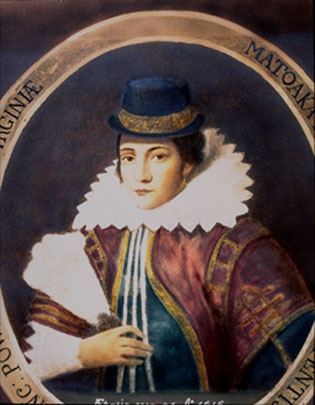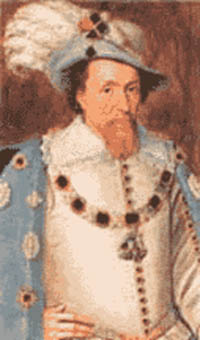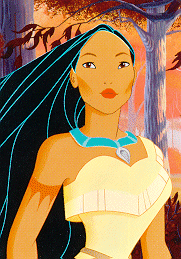

Pocahontas
Pocahontas was an Indian princess, the daughter
of Powhatan, the powerful chief of the Algonquian Indians in the Tidewater
region of Virginia. She was born around 1595 to one of Powhatan's many
wives. They named her Matoaka, though she is better known as Pocahontas,
which means "Little Wanton," playful, frolicsome little girl.
Pocahontas probably saw Europeans for the first
time in May, 1607, when Englishmen landed at Jamestown. The one she found
most likable was Captain John Smith. The first meeting of Pocahontas and
John Smith is a legendary story, romanticized (if not entirely invented)
by Smith. He was leading an expedition in December, 1607, when he was taken
captive by some Indians. Days later, he was brought to the official residence
of Powhatan at Werowocomoco, which was 12 miles from Jamestown. According
to Smith, he was first welcomed by the great chief and offered a feast.
Then he was grabbed and forced to stretch out on two large, flat stones.
Indians stood over him with clubs as though ready to beat him to death
if ordered. Suddenly a little Indian girl rushed in and took Smith's "head
in her arms and laid her owne upon his to save him from death." The girl,
Pocahontas, then pulled him to his feet. Powhatan said that they were now
friends, and he adopted Smith as his son, or a subordinate chief. Actually,
this mock "execution and salvation" ceremony was traditional with the Indians,
and if Smith's story is true, Pocahontas' actions were probably one part
of a ritual. At any rate, Pocahontas and Smith soon became friends.
In October, 1609, John Smith was badly injured
by a gunpowder explosion and was forced to return to England. In 1613,
Pocahontas met another Englishman, John Rolfe, who wanted to marry her,
but only after she agreed to convert to Christianity. She agreed. And thus,
Pocahontas was baptized, christened Rebecca, and married John Rolfe on
April 5, 1614. In 1616, seeking financial support for the Jamestown
colony, Sir Thomas Dale made an important voyage back to London. As a publicity
stunt, he brought with him about a dozen Algonquian Indians, including
Pocahontas. Her husband and their young son, Thomas, accompanied her. The
arrival of Pocahontas in London was well publicized. She was presented
to King James I, the royal family, and the rest of the best of London society.
Also in London at this time was Captain John Smith, the old friend she
had not seen for eight years and whom she believed was dead. According
to Smith at their meeting, she was at first too overcome with emotion to
speak. After composing herself, Pocahontas talked of old times.
In March 1617, Rolfe decided to return his family
to Virginia, but before they could set sail, Pocahontas fell ill with,
perhaps, pneumonia or tuberculosis. She died within a few days at the age
of 22 and was buried in a churchyard in Gravesend, England.
In 1616, seeking financial support for the Jamestown
colony, Sir Thomas Dale made an important voyage back to London. As a publicity
stunt, he brought with him about a dozen Algonquian Indians, including
Pocahontas. Her husband and their young son, Thomas, accompanied her. The
arrival of Pocahontas in London was well publicized. She was presented
to King James I, the royal family, and the rest of the best of London society.
Also in London at this time was Captain John Smith, the old friend she
had not seen for eight years and whom she believed was dead. According
to Smith at their meeting, she was at first too overcome with emotion to
speak. After composing herself, Pocahontas talked of old times.
In March 1617, Rolfe decided to return his family
to Virginia, but before they could set sail, Pocahontas fell ill with,
perhaps, pneumonia or tuberculosis. She died within a few days at the age
of 22 and was buried in a churchyard in Gravesend, England.
 The
Disney Movie, "Pocahontas", is accurate in some respects. It captures the
spirit of the woman Pocahontas and her people, and the spirit of the early
days of Jamestown. The settings are accurate: both Jamestown and Powhatan
village are portrayed authentically, according to current historical and
archaeological knowledge. So are London, the American wilderness, and the
ship Susan Constant. John Ratcliffe was in charge of the colony when John
Smith was captured and released by Powhatan. And last but not least, John
Smith wrote that he was saved from execution by Powhatan, when Pocahontas
threw herself between Smith's head and her father's stone club.
The movie is also inaccurate in some respects.
Pocahontas and John Smith are portrayed as being young adults at the same
time. Pocahontas was only a girl of twelve (or younger) when she met the
veteran adventurer John Smith and (possibly) rescued him from execution
by Powhatan. He was in his late twenties at that time. It is uncertain
whether John Smith was telling the truth when he wrote the story of the
rescue. And the movie changed some of the details of that rescue. Smith
was not out alone, or at night, or going to meet anyone when it happened.
The execution ceremony was not outdoors, and the colony made no attempt
to rescue him. Also, in the move, Ratcliffe was not in charge of the ships
on the way over, he was not in charge of the colony at first, and he was
never Governor. The friends of Pocahontas and John Smith are fictional,
of course, although some of the names are taken from real life.
The
Disney Movie, "Pocahontas", is accurate in some respects. It captures the
spirit of the woman Pocahontas and her people, and the spirit of the early
days of Jamestown. The settings are accurate: both Jamestown and Powhatan
village are portrayed authentically, according to current historical and
archaeological knowledge. So are London, the American wilderness, and the
ship Susan Constant. John Ratcliffe was in charge of the colony when John
Smith was captured and released by Powhatan. And last but not least, John
Smith wrote that he was saved from execution by Powhatan, when Pocahontas
threw herself between Smith's head and her father's stone club.
The movie is also inaccurate in some respects.
Pocahontas and John Smith are portrayed as being young adults at the same
time. Pocahontas was only a girl of twelve (or younger) when she met the
veteran adventurer John Smith and (possibly) rescued him from execution
by Powhatan. He was in his late twenties at that time. It is uncertain
whether John Smith was telling the truth when he wrote the story of the
rescue. And the movie changed some of the details of that rescue. Smith
was not out alone, or at night, or going to meet anyone when it happened.
The execution ceremony was not outdoors, and the colony made no attempt
to rescue him. Also, in the move, Ratcliffe was not in charge of the ships
on the way over, he was not in charge of the colony at first, and he was
never Governor. The friends of Pocahontas and John Smith are fictional,
of course, although some of the names are taken from real life.

 Return
to Study Guide #1
Return
to Study Guide #1
 Revised
January 14, 2000
Revised
January 14, 2000
by Tom Gallup, e-mail address: [email protected]
West Valley College
http://www.westvalley.edu/wvc/ss/gallup/gallup.html




 The
Disney Movie, "Pocahontas", is accurate in some respects. It captures the
spirit of the woman Pocahontas and her people, and the spirit of the early
days of Jamestown. The settings are accurate: both Jamestown and Powhatan
village are portrayed authentically, according to current historical and
archaeological knowledge. So are London, the American wilderness, and the
ship Susan Constant. John Ratcliffe was in charge of the colony when John
Smith was captured and released by Powhatan. And last but not least, John
Smith wrote that he was saved from execution by Powhatan, when Pocahontas
threw herself between Smith's head and her father's stone club.
The
Disney Movie, "Pocahontas", is accurate in some respects. It captures the
spirit of the woman Pocahontas and her people, and the spirit of the early
days of Jamestown. The settings are accurate: both Jamestown and Powhatan
village are portrayed authentically, according to current historical and
archaeological knowledge. So are London, the American wilderness, and the
ship Susan Constant. John Ratcliffe was in charge of the colony when John
Smith was captured and released by Powhatan. And last but not least, John
Smith wrote that he was saved from execution by Powhatan, when Pocahontas
threw herself between Smith's head and her father's stone club.